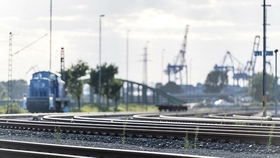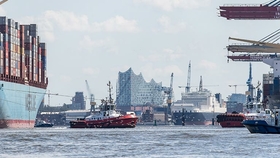
We are an institution under public law and we also exercise sovereign functions as a transit authority. We are the Water Authority in the port area and have a wide range of tasks in the construction supervision and environment unit. The HPA is therefore your point of contact for all issues relating to water- and landside infrastructure, the safety of ship traffic, Port Railway faicilities, real estate management and the economic development of the port. Together with all those who use the port infrastructure every day, we ensure everything runs smoothly.
The HPA is in accordance with the Hamburg Public Roads, Lanes and Pathways Act (Hamburgisches Wegegesetz (HWG)), the Authority in charge of building and maintaining public roads, lanes and pathways and the Regulatory Authority in charge of public roads, lanes and pathways. One of our diverse areas of responsibility is also the granting of permits for the use of public roads and routes in the port area. As a water Authority, we monitor the condition and use of water bodies and flood protection systems, and function as Dyke Control Office and Supervisory authority in charge of defence polders in our area of responsibility. We are responsible for water permits and Approvals pursuant to the Hamburg Ordinance on Public Flood Defence Facilities as well as for Permits issued pursuant to defence polder laws. A wide range of tasks is bundled in the construction supervision and environment unit. The development projects in the port of Hamburg form the focus here. In addition to consulting and service offers that are primarily aimed at customers within the HPA, we also play an important role in the perception of the public service responsibilities of the Hamburg Port Authority towards our port customers. We are closely networked with the other authorities in Hamburg.
Here is where you can find all the downloads available in the “Authorities” section.
| Pangritz, Sinje [Translate to English:] Head of Public Affairs / Press Officer | -1- | [Translate to English:] Ihr Ansprechpartner: |
Pangritz, Sinje
[Translate to English:] Head of Public Affairs / Press Officer
Neuer Wandrahm 4
20457
Hamburg
+49 40 42847-2301

|
| Dlugosch, Jan Shipping police approvals | -6- | Your contact: |
Dlugosch, Jan
Shipping police approvals
Oberhafenamt
Neuer Wandrahm 4
20457
Hamburg
+49 40 42 84 7-2575

|
| Pillkahn, Jens [Translate to English:] Leiter Servicecenter Railway Infrastructure | -4- | [Translate to English:] Ihr Ansprechpartner: |
Pillkahn, Jens
[Translate to English:] Leiter Servicecenter Railway Infrastructure
Hafenbahn
Veddeler Damm 14 a/b
20457
Hamburg
+49 40 42847-5570

|
| Port Dues Office | -42- | Port Dues Office |
Port Dues Office
+49 40 42847-5500

|
Hier finden Sie alle Downloads aus dem Bereich Behörde
| Sustainability Report 2013/2014 | -Reports- | Sustainability Report 2013/2014 | ||
| Sustainability Report 2011/2012 | -Reports- | Sustainability Report 2011/2012 | ||
| Annual Report 2010 | -Reports- | Annual Report 2010 | ||
| Project Report Benchmark of Environmental Emission for Railway Hinterland Transport from the Port Of Hamburg 2010 | -Reports- |
Project Report Benchmark of Environmental Emission for Railway Hinterland Transport from the Port Of Hamburg 2010 |
||
| The Port Development Plan to 2025 | -Concepts- | The Port Development Plan to 2025 | ||
| Annual Report 2016 | -Reports- | Annual Report 2016 | ||
| Sustainability Report 2015/2016 | -Reports- | Sustainability Report 2015/2016 | ||
| Port Information Guide 2023 | -General Information- -Brochures- | Port Information Guide 2023 | ||
| Port Information Guide 2022 | -General Information- -Instructions / Regulations- -Reports- -Brochures- | Port Information Guide 2022 | ||
| Nachhaltigkeitsbericht 2013/2014 | -Reports- | Nachhaltigkeitsbericht 2013/2014 | ||
| Nachhaltigkeitsbericht 2013/2014 Zahlenteil | -Reports- | Nachhaltigkeitsbericht 2013/2014 Zahlenteil | ||
| Sustainability Report 2013/2014 | -Reports- | Sustainability Report 2013/2014 | ||
| Sustainability Report 2011/2012 | -Reports- | Sustainability Report 2011/2012 | ||
| Annual Report 2010 | -Reports- | Annual Report 2010 | ||
| Project Report Benchmark of Environmental Emission for Railway Hinterland Transport from the Port Of Hamburg 2010 | -Reports- |
Project Report Benchmark of Environmental Emission for Railway Hinterland Transport from the Port Of Hamburg 2010 |
||
| The Port Development Plan to 2025 | -Concepts- | The Port Development Plan to 2025 | ||
| Annual Report 2016 | -Reports- | Annual Report 2016 | ||
| Sustainability Report 2015/2016 | -Reports- | Sustainability Report 2015/2016 | ||
| Hafen-GTC 2019, effective as of 01 January 2019 | -GTC Marine Infrastructure- -General Information- -Port Fees- | Hafen-GTC 2019, effective as of 01 January 2019 | ||
| Port Information Guide 2023 | -General Information- -Brochures- | Port Information Guide 2023 | ||
| Port Information Guide 2022 | -General Information- -Instructions / Regulations- -Reports- -Brochures- | Port Information Guide 2022 | ||
| Nachhaltigkeitsbericht 2013/2014 | -Reports- | Nachhaltigkeitsbericht 2013/2014 | ||
| Nachhaltigkeitsbericht 2013/2014 Zahlenteil | -Reports- | Nachhaltigkeitsbericht 2013/2014 Zahlenteil |
The Port of Hamburg is constantly developing and changing. Associated with this are numerous structural engineering projects within the port that are carried out every year. Amongst these are new building projects started for logistics centres and warehouses, office and social buildings as well as workshops and paved areas and even oil terminals. Where existing building stock is concerned, the work involves rebuilding and conversions of both buildings and industrial plants. For most of these projects, a building permit is required.
The Building Control Authority of the Hamburg Port Authority, rather the Development Projects Division, is responsible for the processing of building permit application throughout the port's area of activity. In general, building permit applications in Hamburg are processed by the Building Control Services Office. However, since 01 October 2006, when the Hamburg Senate decreed otherwise, the Hamburg Port Authority has been responsible for the processing of building applications within the Port of Hamburg rather than the Building Control Services Office.
The tasks of the Building Control Authority include the advising of industrial companies, architects and construction companies in the execution of planned building measures in the dedicated port area of activity in respect of public service issues, the processing of approval processes according to Sections 61, 62 and 63 of the Hamburg Building Ordinance (HBauO), the awarding of corresponding approval decisions and repressive actions in the event of structural issues.
In the concentrating official building approval process in accordance with Section 62 HBauO, the most frequently implemented approval process, all necessary public service decisions are gathered from the responsible positions by the Building Control Authority as the process manager and consolidated in an administrative measure (building permit). This central permit contains all essential authorisations that are necessary for the execution of a building project.
Moreover, the named tasks are administered within the scope of Immission control procedures (approval process according to the Federal Immission Control Act – BImSchG).
The Hamburg Port Authority administers exceptions to the ordinance on warfare agents.
Do you want to erect a building or change a building's use within the dedicated port area?
Do you want to submit a Building permit application or clarify a Binding decision by a building permit authority delivered prior to submitting a building permit application?
Do you want to know if a project requires a building permit?
Do you intend to set up an advertising panel, set up a Portakabin office, arrange a music festival or even erect a power station?
For these and other questions about official building approval process and information about development options within the Port of Hamburg (Dedicated port area) we are your competent point of contact.
You're going to be linked to the Authority for Urban Development and Living (German):
You can finde the forms on the website of the Authority for Urban Development and Living (German):
You can find a list of Building Control Services on the website of the Authority for Urban Development and Living (German):
You can find Updates concerning the Global Guidelines on the website of the Authority for Urban Development and Living (German):
Buildings and structures must be stable to ensure the safety and orderliness of the public and public spaces. Their stability is to be proven by both structural engineers and inspection engineers (in line with the dual-control principle). Structural engineers are normally commissioned by the building’s owner, who then must provide the required documentation to the building supervisory authority for examination. The “Structural examination office for the port” is responsible for performing the examination of technical construction documents and is supported by the examination engineers for structural engineering. Examination engineers analyse the load calculations and the blueprints, and they monitor at random the implementation of these on the construction site. In this way, any errors in building construction and in the execution of construction work can be avoided. Any costs to the building’s owner resulting from such errors can be eliminated and the safety to the public, which the state requires, can be guaranteed.
Statische Prüfstelle Hafen
Tel. +49 40 42847- 3262
statischepruefstellehafen@hpa.hamburg.de
We, the Water Authority of the HPA, monitor the condition and use of water bodies and flood protection systems, and function as Dyke Control Office and Supervisory authority in charge of defence polders in our area of responsibility. We are responsible for water permits and Approvals pursuant to the Hamburg Ordinance on Public Flood Defence Facilities as well as for Permits issued pursuant to defence polder laws.
In accordance with the Hamburg Water Act (HWaG), any use of the water that extends beyond public use requires the approval of the water authority. In particular, constructing or altering installations in, on or over the water require approval. Examples of such installations are:
• "stationary objects" (e.g.: plinths, pontoons, floating houses)
• all structures in, on and over the water (buildings, balustrades, bridges)
• other equipment (e.g.: slaloms, signage, outlet structures)
• work in, on or over the water (e.g.: scaffolding, drilling)
Any use of or damage to a public flood defence facility is prohibited, except for the purpose of its upkeep, restoration and maintenance. In accordance with the Hamburg Ordinance on Public Flood Defence Facilities (DeichO), we may grant revocable exceptions to this ban. Examples of usage requiring approval are:
• construction work, including footings in the base of the embankment
• crossings
• pipeline intersections or viaducts
Any building work, excavation, landscaping and loading must be over 10 kN/m² away from the private flood defence facilities with double-sided protective strips and pipelines. In accordance with the Defence Polder Ordinance (PolderO), we may approve exceptions. Examples of where approval is required are:
• construction work, including footings in the protective strips (impact area) of the flood defences
• pipeline intersections or viaducts
• other loads (e.g.: temporary building site facilities)
As the Authority in charge of public roads, lanes and pathways, the HPA performs Statutory duties and grants approvals for the use of the public roads and highways in the port area. HPA therefore acts as the Authority in charge of building and maintaining public roads, lanes and pathways and Regulatory authority in charge of public roads, lanes and pathways in accordance with the Hamburg Public Roads, Lanes and Pathways Act and undertakes the following tasks.
Unregistered vehicles may not park on public roads. The highways authority monitors this and arranges to have the vehicles towed away free of charge if necessary.
All newly built roads and highways must be officially transfered into public ownership, provided they are intended to be made available to public traffic. The granting and withdrawal of this legal status is undertaken by the HPA as the highways authority.
An excavation permit must be obtained for excavations affecting the carriageways of public roads and highways and adjoining areas. Since the beginning of 2013, applications can only be made electronically, via the Internet.
Constructing and altering access roads also requires the approval of the Authority in charge of building and maintaining public roads, lanes and pathways. The necessary application form can be requested from the Authority in charge of public roads, lanes and pathways by e-mail.
Any use of public land that extends beyond public use requires approval. The Authority in charge of public roads, lanes and pathways team will be happy to advise applicants and accept their requests through their e-mail address.
Route approval is required for all supply and disposal pipes, which are newly installed in the roads or which will significantly alter existing routes. This is undertaken almost exclusively by the pipeline company. Applications are submitted to the Authority in charge of public roads, lanes and pathways.
As the Local Nature Conservation Authority in the dedicated port area, the HPA administers numerous regulatory tasks in respect of nature and landscape conservation. It is responsible for control and monitoring tasks that arise from the implementation of national and international legal regulations.
• Statements concerning construction projects
• Statements / participation in planning and approval processes
• Handling of the right of intervention according to Sections 14 et seqq. BNatSchG (Federal Nature Conservation Law)
• Awarding of exceptions and waivers (e.g. Tree Protection Regulation; general species and biotope protection)
• Monitoring compliance with the regulations of nature and landscape conservation
• Arrangements for the implementation of conservation and development measures
• Execution of conservation area ordinance
• Checking of immission control needs
• Monitoring of the adherence to species and biotope protection conditions
• Felling of woods (BaumSchVO; Section 30 BNatSchG; Section 44 BNatSchG)
• Demolition of buildings (Section 44 BNatSchG)
• Encroachment onto areas that have not yet been paved over (Sections 14 et seqq. BNatSchG)

Further information about nature conservation and contact persons:
Doris Müller
Leiterin Umwelt- und Naturschutz
Tel: +49 40 42847-3903
Doris.Mueller@hpa.hamburg.de
Reik Weidner
Baumschutzreferent
Tel: +49 40 42847-2098
Reik.Weidner@hpa.hamburg.de
If any of these topics are relevant to your planning, then please contact us early on in the process. We will provide you with comprehensive advice so that your planning is ultimately legally secure.
Federal Nature Conservation Act
The Soil Protection Authority implements the regulations of the Federal Soil Protection Act. The purpose of the Federal Soil Protection Act is to permanently protect the functions of the soil or, where necessary, to recreate its functions.
The Soil Protection Authority is moreover the point of contact if you have any questions about warfare agent ordinance. In particular the Hamburg Port Authority, is responsible for administering exceptions to the ordinance on warfare agents.
If you have any questions about soil conservation, please contact:
Andreas Wessolowski
Neuer Wandrahm 4
20457 Hamburg
Phone: +49 (0) 40 42847-2779
BodenschutzbehoerdeKampfmittel@hpa.hamburg.de
Area information system for contaminated sites / contaminated site reference registry
Safely building on contaminated sites
For queries regarding water pollution control and waste disposal, please contact:
Thomas Leitz
Gewässerschutz und Abfallentsorgung
Hafenbehörde / Umwelt- und Naturschutz
Neuer Wandrahm 4
20457 Hamburg / Altstadt
Tel: +49 40 42847-2496
Thomas.Leitz@hpa.hamburg.de
Latest changes to the laws
HPA guide to the ANV
Land use planning within the Port of Hamburg takes place using its own planning law according to the Port of Hamburg Development Law. Planning through the use of development plans according to the Town and Country Planning Code does not occur in the port of Hamburg. The port area is subdivided into the dedicated port area and the port's expansion area. The dedicated port area is already claimed for port activities. Here activities arising from port traffic, trade associated with the port and port industry are permitted. The port planning law is used to ensure that areas which can be used for port purposes are used for these purposes so that the scarce land resource is used efficiently.
A further planning control can be provided by port planning byelaws which are currently applicable in the Altenwerder, Upper Elbe and Kleiner Grasbrook/Steinwerder areas.
The question of whether a development or a new use adheres to these rules is automatically checked as part of each building application.
Port planning law
Neuer Wandrahm 4
20457 Hamburg
Germany
Mail: PlanungsrechtHafen@hpa.hamburg.de
You will be linked to the website of Hamburg’s judicial authority.